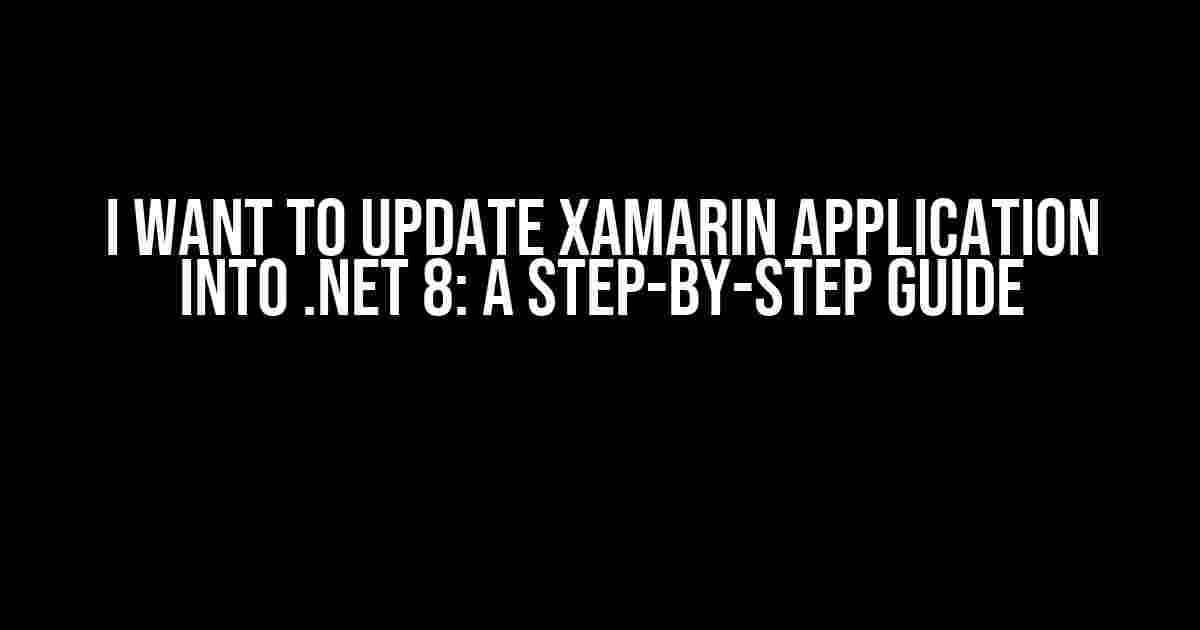Are you tired of using outdated technologies and wanting to upgrade your Xamarin application to the latest .NET 8 framework? Look no further! In this comprehensive guide, we’ll walk you through the process of updating your Xamarin application to .NET 8, ensuring you’re ahead of the curve and taking advantage of the latest features and improvements.
Why Update to .NET 8?
Before we dive into the update process, let’s discuss the benefits of migrating to .NET 8:
- Performance Improvements**: .NET 8 brings significant performance enhancements, including faster startup times, improved memory management, and better garbage collection.
- Native AOT Compilation**: .NET 8 introduces native AOT (Ahead-Of-Time) compilation, which enables faster execution and better performance.
- Enhanced Security**: .NET 8 includes enhanced security features, such as improved cryptography, secure string handling, and better error handling.
- New APIs and Libraries**: .NET 8 provides access to new APIs and libraries, including improved support for machine learning, data analytics, and cloud computing.
Preparation is Key: Before You Start
Before updating your Xamarin application to .NET 8, make sure you’ve completed the following steps:
- Backup Your Project**: Create a backup of your entire project to ensure you can revert to the previous version if needed.
- Update Your IDE**: Ensure you’re using the latest version of Visual Studio or your preferred IDE.
- Check Your SDKs and Libraries**: Verify that all SDKs and libraries used in your project are compatible with .NET 8.
- Review Breaking Changes**: Familiarize yourself with the breaking changes in .NET 8 to avoid potential issues.
Step 1: Update Your Target Framework
To update your Xamarin application to .NET 8, you’ll need to change the target framework in your project:
<Project Sdk="Microsoft.NET.Sdk">
<PropertyGroup>
<TargetFramework>net8.0</TargetFramework>
</PropertyGroup>
...
</Project>
In the above code, we’ve updated the `` element to `net8.0`, which targets the .NET 8 framework.
Step 2: Update NuGet Packages
Many NuGet packages need to be updated to be compatible with .NET 8. Use the following command to update all packages:
dotnet update
This command will update all packages to the latest version compatible with .NET 8.
Step 3: Update Xamarin.Forms
If you’re using Xamarin.Forms, you’ll need to update it to the latest version:
Install-Package Xamarin.Forms -Version 5.0.0
In this example, we’ve installed Xamarin.Forms version 5.0.0, which is compatible with .NET 8.
Step 4: Update Xamarin.Essentials
Xamarin.Essentials is a popular library that provides essential APIs for Xamarin applications. Update it to the latest version:
Install-Package Xamarin.Essentials -Version 1.7.0
Step 5: Update Your Code
With the target framework and NuGet packages updated, it’s time to review and update your code to take advantage of .NET 8 features:
public class MyClass
{
public void MyMethod()
{
// Use .NET 8 features, such as improved pattern matching
if (myObject is MyClass { MyProperty: 42 })
{
Console.WriteLine("MyProperty is 42");
}
}
}
In this example, we’ve used improved pattern matching, which is a new feature in .NET 8.
Troubleshooting Common Issues
During the update process, you may encounter issues. Here are some common problems and their solutions:
| Issue | Solution |
|---|---|
| Compiler errors | Review the error messages and update your code to be compatible with .NET 8. |
| NuGet package conflicts | Use the `dotnet restore` command to restore packages and resolve conflicts. |
| Runtime errors | Use debugging tools to identify the issue and update your code accordingly. |
Conclusion
Updating your Xamarin application to .NET 8 is a significant step towards taking advantage of the latest features and improvements. By following this guide, you’ll be able to successfully migrate your application and enjoy the benefits of .NET 8. Remember to backup your project, review breaking changes, and update your code to ensure a smooth transition.
Happy coding!
Frequently Asked Question
Are you excited to level up your Xamarin application to .NET 8? We’ve got you covered! Here are some frequently asked questions to help you on your upgrade journey:
What are the benefits of upgrading my Xamarin application to .NET 8?
By upgrading to .NET 8, you’ll get to enjoy the latest features, performance improvements, and security enhancements. You’ll also be able to take advantage of the unified .NET platform, which means you can share code and libraries across web, mobile, and desktop applications. It’s a win-win!
Will my Xamarin application still work on older devices after the upgrade?
Yes, .NET 8 is designed to be backward compatible, so your Xamarin application will still work on older devices that support Xamarin.Android and Xamarin.iOS. However, keep in mind that you might need to make some adjustments to your code to take advantage of the new features and APIs.
Do I need to rewrite my entire Xamarin application to use .NET 8?
No, you don’t need to rewrite your entire application. The .NET 8 upgrade process is designed to be incremental, so you can upgrade your Xamarin application in phases. You can start by upgrading your shared code, then move on to your platform-specific code, and finally, update your UI and UX.
What are the system requirements for developing Xamarin applications with .NET 8?
To develop Xamarin applications with .NET 8, you’ll need Visual Studio 2022 or later, .NET 8 SDK, and the latest versions of Xamarin.Android and Xamarin.iOS. You’ll also need a Mac computer with Xcode 14 or later installed if you’re developing iOS applications.
Where can I find more resources to help me with the upgrade process?
You can find a wealth of information on the official .NET and Xamarin documentation websites, including tutorials, guides, and migration tools. You can also join the .NET and Xamarin communities on GitHub, Stack Overflow, and other online forums to connect with developers who have undergone the upgrade process.
